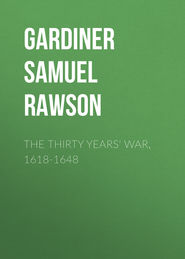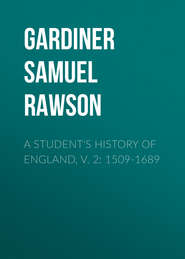По всем вопросам обращайтесь на: info@litportal.ru
(©) 2003-2024.
✖
What Gunpowder Plot Was
Настройки чтения
Размер шрифта
Высота строк
Поля
246
Lindsay at last got off to Rome in November 1604. On his proceedings there see History of England, 1603-1642, i. 224.
247
In the MS. ‘et non haverebbe.’ Mr. Rawdon Brown, amongst whose papers, now in the Record Office, this despatch is found, remarks that mistakes of this kind frequently occur in letters first ciphered and then deciphered.
248
In the margin is ‘Questo poi è troppo,’ perhaps an addition by the ambassador, or even by Mr. Rawdon Brown.
249
‘Religione’ is suggested by Mr. Rawdon Brown for the ‘ragione’ of the decipherer.
250
In the copy ‘non si può far di meno di non observar le leggi,’ the ‘non’ being incorrectly repeated.
251
“Non predicando li preti nessuna cosa più constantemente di questa che il buon Cattolico bisogna che habbia questa ferma rissolutione in se medesimo di esser per conservar la Religione pronto a solevarsi etiam contra la vita e stato del suo Principe naturale.”
252
Molin to the Doge, March 7/17, 1605, Venetian Transcripts, R.O.
253
Lindsay to James I. Jan. 26/Feb. 5, 1605, S. P. Italian States.
254
Compare the last passage quoted from Molin’s despatch, p. 161.
255
This is, however, precisely what James had failed to induce the Pope to do.
256
Father Gerard asks what ‘our offence’ was. It was clearly nothing personal to the writer, and I am strongly inclined to interpret the words as referring to Lindsay’s proceedings at Rome, of which so much had been made.
257
Sir Everard Digby to Salisbury (S. P. Dom. xvii. 10.) As Father Gerard says, the date cannot be earlier than May 4, 1605, when the Earldom was conferred on Cranborne.
258
Father Gerard gives the date of Davies’s pardon from the Pardon Roll as April 25, 1605. It should be April 23, 1604.
259
Gerard, 94, 95, 254. Father Gerard ascribes this application to ‘a later date’ than March 1606. It was, in fact a good deal later, as the endorsement ‘Mr. Secretary Conway’ shows that it was not earlier than 1623. The further endorsement ‘touching Wright and his services performed in the damnable plot of the Powder Treason,’ proves nothing. What did Conway’s clerk know beyond the contents of the application itself?
260
Father Gerard (p. 98) tells us of one Thomas Coe, who wrote on Dec. 20, 1605, telling him that he had forwarded to the King ‘the primary intelligence of these late treasons.’ If this claim was justified, why do we not find Coe’s name, either amongst the State Papers or on the Patent Rolls, as recipient of some favour from the Crown? A still more indefensible argument of Father Gerard’s is one in which a letter written to Sir Everard Digby about an otter hunt is held (p. 103) to show the existence of Government espionage, because though written before Digby was acquainted with the plot it is endorsed, ‘Letter written to Sir Everard Digby – Powder Treason.’ Any letter in Digby’s possession would be likely to be endorsed in this way whatever its contents might have been.
261
Gerard, pp. 95, 96.
262
Gerard, p. 106.
263
Salisbury to Edmondes, Oct. 17, 1605. —Stowe MSS. 168, fol. 181.
264
See History of England, 1603-1642, i. 238, 243.
265
Garnet’s Declaration, March 9, 1606. —Hist. Rev. July, 1888, p. 513.
266
Father Gerard gives a facsimile, p. 199.
267
Harl. MSS. 360, fol. 112 b.
268
See p. 128.
269
As in the case of the merchant who refused to pay the imposition on currants, ‘Bate’ and ‘Bates’ were considered interchangeable.
270
G. P. B., No. 145. The words in italics are added in a different hand. Dunbar’s name does not occur in the list of Commissioners at p. 24.
Lindsay at last got off to Rome in November 1604. On his proceedings there see History of England, 1603-1642, i. 224.
247
In the MS. ‘et non haverebbe.’ Mr. Rawdon Brown, amongst whose papers, now in the Record Office, this despatch is found, remarks that mistakes of this kind frequently occur in letters first ciphered and then deciphered.
248
In the margin is ‘Questo poi è troppo,’ perhaps an addition by the ambassador, or even by Mr. Rawdon Brown.
249
‘Religione’ is suggested by Mr. Rawdon Brown for the ‘ragione’ of the decipherer.
250
In the copy ‘non si può far di meno di non observar le leggi,’ the ‘non’ being incorrectly repeated.
251
“Non predicando li preti nessuna cosa più constantemente di questa che il buon Cattolico bisogna che habbia questa ferma rissolutione in se medesimo di esser per conservar la Religione pronto a solevarsi etiam contra la vita e stato del suo Principe naturale.”
252
Molin to the Doge, March 7/17, 1605, Venetian Transcripts, R.O.
253
Lindsay to James I. Jan. 26/Feb. 5, 1605, S. P. Italian States.
254
Compare the last passage quoted from Molin’s despatch, p. 161.
255
This is, however, precisely what James had failed to induce the Pope to do.
256
Father Gerard asks what ‘our offence’ was. It was clearly nothing personal to the writer, and I am strongly inclined to interpret the words as referring to Lindsay’s proceedings at Rome, of which so much had been made.
257
Sir Everard Digby to Salisbury (S. P. Dom. xvii. 10.) As Father Gerard says, the date cannot be earlier than May 4, 1605, when the Earldom was conferred on Cranborne.
258
Father Gerard gives the date of Davies’s pardon from the Pardon Roll as April 25, 1605. It should be April 23, 1604.
259
Gerard, 94, 95, 254. Father Gerard ascribes this application to ‘a later date’ than March 1606. It was, in fact a good deal later, as the endorsement ‘Mr. Secretary Conway’ shows that it was not earlier than 1623. The further endorsement ‘touching Wright and his services performed in the damnable plot of the Powder Treason,’ proves nothing. What did Conway’s clerk know beyond the contents of the application itself?
260
Father Gerard (p. 98) tells us of one Thomas Coe, who wrote on Dec. 20, 1605, telling him that he had forwarded to the King ‘the primary intelligence of these late treasons.’ If this claim was justified, why do we not find Coe’s name, either amongst the State Papers or on the Patent Rolls, as recipient of some favour from the Crown? A still more indefensible argument of Father Gerard’s is one in which a letter written to Sir Everard Digby about an otter hunt is held (p. 103) to show the existence of Government espionage, because though written before Digby was acquainted with the plot it is endorsed, ‘Letter written to Sir Everard Digby – Powder Treason.’ Any letter in Digby’s possession would be likely to be endorsed in this way whatever its contents might have been.
261
Gerard, pp. 95, 96.
262
Gerard, p. 106.
263
Salisbury to Edmondes, Oct. 17, 1605. —Stowe MSS. 168, fol. 181.
264
See History of England, 1603-1642, i. 238, 243.
265
Garnet’s Declaration, March 9, 1606. —Hist. Rev. July, 1888, p. 513.
266
Father Gerard gives a facsimile, p. 199.
267
Harl. MSS. 360, fol. 112 b.
268
See p. 128.
269
As in the case of the merchant who refused to pay the imposition on currants, ‘Bate’ and ‘Bates’ were considered interchangeable.
270
G. P. B., No. 145. The words in italics are added in a different hand. Dunbar’s name does not occur in the list of Commissioners at p. 24.









